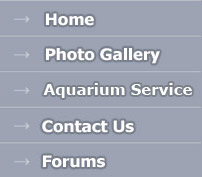D. compressiceps commonly known as the "Malawi Eye-Biter," is a large and impressive open-water predator. This fish is constantly on the prowl, and therefore is not territorial, unless preparing to spawn. In appearance, it is typically a whitish-silver with a single brown horizontal stripe on its side. Sexually mature males put on quite a display of colors: electric blue with fluorescent reds and oranges on their fins. It is a rather distinctive fish in that its jaw alone is approximately one-third its total body length. With this huge mouth, D. compressiceps females are able to brood 250 fry at a time! If you ever see one of these monsters open its mouth, you'll understand how it can brood that many.
Also of note is its unique hunting style: Dimidiochromis compressiceps, whose name is derived from its compressed body, uses its extremely narrow body to its advantage in ambushing prey. It hunts with its head angled downward, and its narrow body outline toward its prey so as to minimize its visibility. D. compressiceps is often cruel to its prey, catching, crippling, and then leaving its prey to die. This fish is incredibly quick and can turn its long body in a flash. They also prefer the open water and tend to hang out at the top of an aquarium, probably because it is more open and less hindered by rocks or plants.
If you plan to keep one of these large preadtors, there are a few things to take into consideration. First of all, keep aquarium decorations to a minimum as they prefer the open, unhindered space. Second, respect that this fish gets quite large (9-12") and requires a large, long tank. Third, and most important, keep in mind that this fish is a predator by nature. Smaller fishes, such as Pseudotropheus speices, should not be kept with D. compressiceps. I learned this lesson the hard way after he swallowed five very valuable Pseudos of mine. Fortunately, all five escaped (they were too big to swallow) and have recovered since being separated. In the wild, this fish preys on other cichlids, mostly Pseudotropheus and Aulonocara species and could easily revert back to this practice in the aquarium if preventive measures are not taken.
For the aquarium, pellets, shrimp, krill, or mussells are recommended foods. They could also be fed feeder fish if the tank doesn't contain any Mbuna or other smaller-sized fishes, because the feeder fish could possibly make them more aggressive toward any smaller tank mates. You could alternatively feed them pieces of cod or smelt, although these are less nutritious than the mussels or shrimp.
Some have reported that the "Malawi Eye-Biter" does not attack the eyes of other fishes with any greater frequency than that of other fishes, but I would have to disagree. I found two similarly sized Labidochromis juveniles missing eyes after being kept for a short time with two very small juvenile compressiceps. I can't prove who did it, but I have never had this happen before or since. And with a nick-name like this, I have strong premonitions about "who dunnit."





